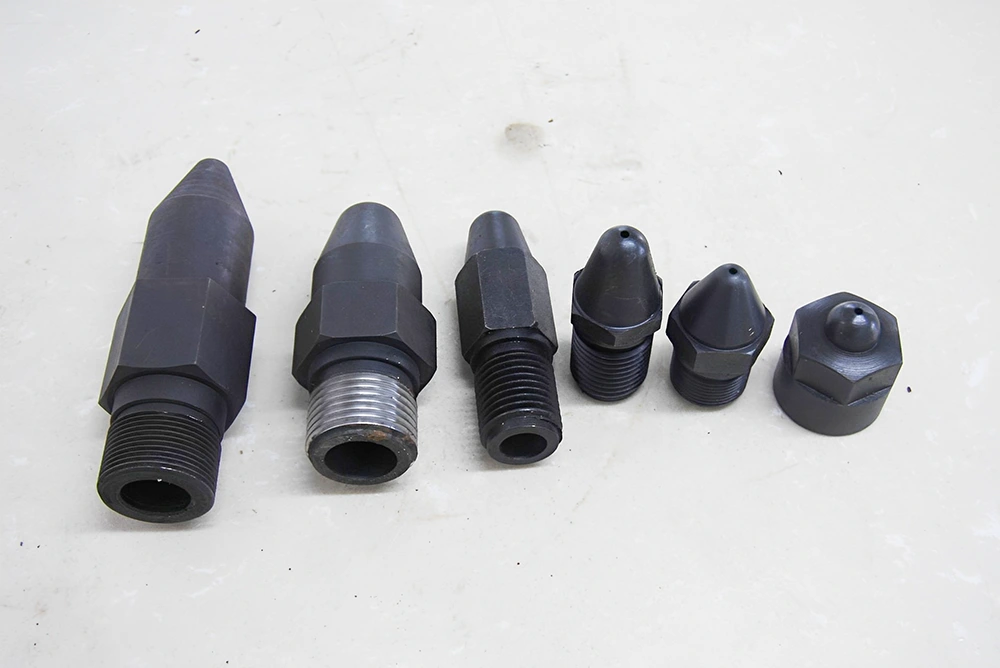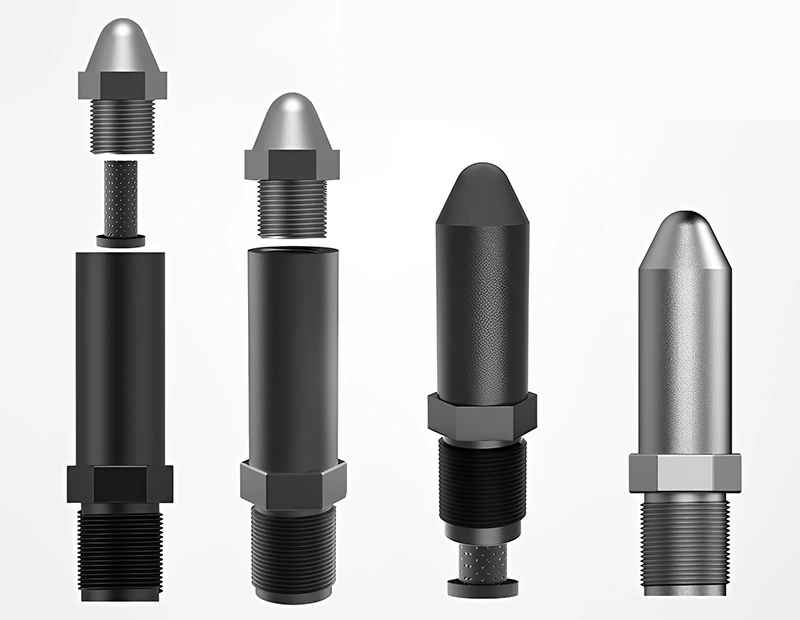Injection molding is a popular and widely used way to make things. An injection molding nozzle is a key part of the ejector system at the bottom of the molding machine. Its main job is to move melted plastic from the barrel into the mold, a key part of making the end product.
The mold’s sprue bushing and locating ring is placed in a way that makes sure the injection molding nozzle is properly aligned and centered. This makes the casting process as efficient and accurate as possible.
This article will discuss the importance of injection molding nozzles and what makes a good nozzle for a molding or injection gate. We’ll also show you the most common problems with injection molding nozzles that you should watch out for when using this element.
Also Read: Understanding Guide Bushing In Injection Mold

Types of an Injection Molding Nozzle:
Modern injection molding machines have nozzles that can do different things, like separate the melt flow, mix it, or stop it. Let’s look more closely at some of the most popular types of nozzles used in molding:
Modular Nozzle Designs:
These nozzles can be quickly screwed onto the barrel of an injection molding machine. They can also be changed to fit the barrels of different machines. They work with only one size and type of injection molding press.
Some are all one piece, while others are modular and have different parts for the nozzle body, machine interface, and mold interface. The flexible design allows a single injection molding nozzle body to work with more than one injection barrel and mold.
Screen-Pack Nozzle Filters:
These nozzles catch impurities in the melt stream so they don’t get into the mold and hurt the parts made. The most common type is the screen pack, a metal disk with small holes all over it.
As the melt moves through the flow path of the nozzle, the metal disk meets it and forces it through the small-diameter holes, catching larger particles or contaminants. Screen packs have some benefits, like being easy to use and cheap, but they can also cause a visible pressure drop, changing how the molding process works.
Gap-Filter Machine Nozzles:
The gap filter, also called an edge filter, is an additional way to filter the melt. The gap filter rotates the melt’s filtering direction by 90°.
This makes a bigger flow area for filtering and a lot less pressure drop than screen packs. It has a cylindrical shape and is perfectly made to fit into the machine nozzle body. Its outer diameter has several parallel melt-flow lines that run lengthwise.
Mixing Nozzles:
These nozzles ensure an even and consistent spread of additives, like colorants, which improves their performance. Mixing tools help make a melt that is more even and uniform in terms of temperature.
As the melt moves through the nozzle, some mixing nozzles change the size of the flow channels to make places with higher and lower pressure. For example, the “triple-action” mixing injection molding nozzle curls the melt into itself to ensure it is thoroughly mixed. It uses spiral flow paths to mix things up gently but effectively.
Shut-Off Nozzles:
In some molding jobs, like multi-shot molding, the machine tip has to move away from the mold between each shot to keep the plastic from dripping. There are many kinds of shut-off nozzles, like shut-off pins, ball-valve shut-offs, and blade shut-offs.
Hydraulics, pneumatics, or springs can turn them on or off. Automatic shut-off is better because it makes the process easier and reduces the chance of mistakes. When the press is not being used for a long time, built-in safety features should keep the pressure from getting too high.
Once you know what each type of nozzle is for and how it works, improving the injection molding process and making high-quality parts may be easier.
Also Read: Everything You Should Know About a Tool Turret in CNC Machines:
Characteristics of a Quality Injection Molding Nozzle:
A good injection molding nozzle tip is essential for making high-quality parts and getting the most out of the molding process. Whether making low-cost or precise parts with sprues, you need the right screw, barrel, and casting nozzle. Let’s take a look at what makes a good tool for injection molding:

Better Mixing Consistency:
The manufacturers made a good mixing tool to smooth the mixing of colors and evenly apply it all over the finished part. It provides a consistent mix by distributing additives and meeting specific resin and colorant needs. This makes high-quality parts.
Even Melting:
To avoid problems like uneven part weight, flow, knit lines, or hole distribution, it is important to get the melt temperature to be uniform. A good mixing tool with different parts that melt at different temperatures can help even out temperature differences and make melting go more smoothly.
Eliminating the Need for Back-Pressure:
Some workers use back-pressure to solve mixing and homogenizing problems, but this can lead to higher shear, pressure buildup, slower output, and longer cycle times. A well-designed mixing nozzle tip can provide a better answer by reducing back pressure, increasing productivity, and making components last longer.
Using Less Colorant:
With mixing tools, you can use up to 30% fewer color additives than without them. This saves money and time and makes the most of the time a machine is working.
Regrinding:
A good mixing tool prevents unevenly ground materials, which leads to less part failure and more regrinding. Using the mixing tool helps you save money and get your money back more quickly.
In a nutshell, buying a good injection molding nozzle, like a standard nozzle tip, a mixed nozzle, or a filter nozzle, can help your molding process and part needs in many ways.
It makes mixing more consistent, melting more evenly, reducing the need for back-pressure, saving money on colorant, and improving regrinding results. These qualities are important if you want to make high-quality parts quickly and improve the performance of your molding activities.
Nozzle Leaks: Troubleshooting a Common Injection Molding Nozzle Defect
As leaks in injection molding tools are a big problem, it’s important to know what causes them and how to fix them quickly. Here’s what you need to know about this:
Low Nozzle Contact Pressure:
If the injection molding nozzle and sprue joint don’t have enough contact pressure, it can cause leaks during the injection molding process.
Solution:
Make sure the machine has enough nozzle contact pressure (4 to 10 tons) to balance out the input pressure. Avoid machines with contact forces at the low end of the range when the input pressure is high.
Too Much Nozzle Contact Area:
Many people think the nozzle tip’s radius should match the sprue bushing’s radius perfectly, but a larger contact area may cause problems.
Solution:
Try a smaller contact ring (3/8-in. to 1/4-in.) on the inside of the sprue bushing to get a better fit without hurting the injection molding nozzle or sprue bushing.
Contact Force on the Edge of the Nozzle Tip:
If the nozzle tip and the sprue bushing don’t have the same radius, the injection unit can leak and move backward.
Solution:
Ensure the needle tip and the sprue bushing are properly aligned and have the same radius to stop leaks and push-back.
Related: How Does an Injection Unit in Injection Molding Machine Function?
Misaligned Injection Unit and Sprue Bushing:
If the injection unit and the sprue bushing are not in the right place, the needle tip or the sprue bushing can wear down, allowing high-pressure plastic to jet.
Solution:
Make sure the injection unit and sprue nut align. Maintenance will need to fix the barrel if it isn’t lined up right.
Wrong Molding Orifice Size on Nozzle or Hot Runner:
When the molding orifice size on the nozzle or hot-runner shape is wrong, injection pressure can push the injection unit back.
Solution:
To stop push-back, ensure the opening molding orifice is the same size or slightly smaller than the hot-sprue-bushing molding orifice.
Radius Mismatch of Nozzle Tip and Sprue Bushing:
It is important to ensure that the radius of the nozzle tip is the same as that of the sprue bushing. This way, they can fit together and close well.
Solution:
In this issue, you can stop the leaks by checking that the radius of the sprue bushing and the tip of the needle are the same.
Distorted or Gouged Nozzle Tip:
The sprue nut and nozzle tip can become damaged over time, which can cause distortions, burrs, or grooves.
Solution:
Check the needle tip and sprue bushing often and take care of them so they don’t get bent or broken.
Note: When working with nozzle-contact forces, safety should always come first. Support the “A” part the right way to keep damage from happening.
During the molding process, watch the cushion and the position of the nozzle contact, and use a dial gauge to check for injection unit push-back. If you pay close attention to these details, you can avoid tip leaks and ensure the injection molding process goes smoothly.
Also Read: Guide Pin in Injection Molding: Enhancing Precision and Efficiency
Wrapping Up:
Ultimately, it’s important to remember that regular care and attention to detail are key to ensuring the nozzles last and work well. By choosing the right injection molding nozzle and doing regular maintenance, manufacturers can improve the overall performance of their injection molding machines and get more reliable and accurate results from their production.










